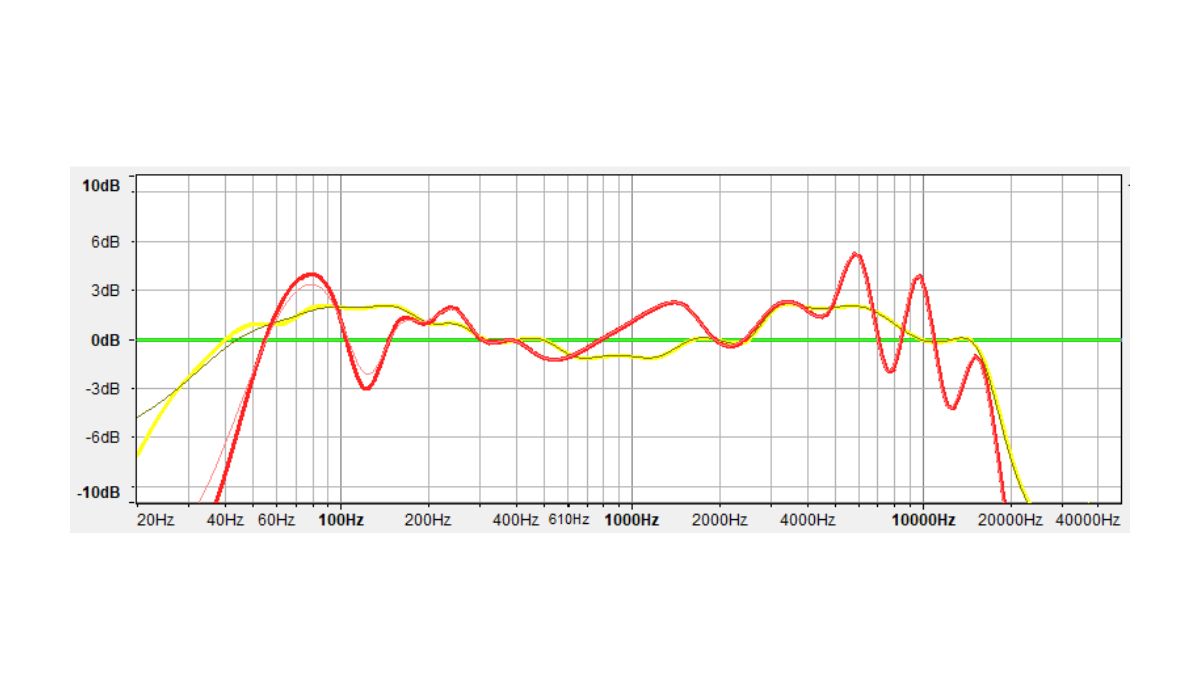Home>Events & Info>Frequency>What Frequency Hurts Dogs’ Ears


Frequency
What Frequency Hurts Dogs’ Ears
Published: February 18, 2024
Learn how certain frequencies can negatively impact your dog's ears and overall well-being. Find out how to protect your furry friend from harmful sound waves.
(Many of the links in this article redirect to a specific reviewed product. Your purchase of these products through affiliate links helps to generate commission for AudioLover.com, at no extra cost. Learn more)
Table of Contents
The Impact of High-Frequency Sounds on Dogs
Dogs have an incredible sense of hearing, far superior to that of humans. This heightened auditory ability allows them to detect a wide range of frequencies, often beyond the capabilities of the human ear. While this acute sense of hearing is a remarkable trait, it also makes dogs particularly sensitive to high-frequency sounds that can cause discomfort or even harm.
The auditory range of dogs extends well beyond that of humans, encompassing frequencies from approximately 40 Hz to 60,000 Hz, compared to the human range of 20 Hz to 20,000 Hz. This means that dogs can perceive sounds at much higher frequencies than we can. While this heightened sensitivity is advantageous in certain scenarios, it also exposes dogs to potential harm from high-pitched noises that may be imperceptible to humans.
The impact of high-frequency sounds on dogs is a topic of growing concern among pet owners and animal welfare advocates. With the increasing prevalence of technology emitting high-pitched tones, such as ultrasonic devices used for pest control or anti-barking deterrents, understanding the effects of these frequencies on canine companions is crucial.
In this article, we will delve into the potential dangers posed by high-frequency sounds to dogs' sensitive ears, explore the signs of discomfort that indicate a dog may be experiencing auditory distress, and provide valuable insights into safeguarding our beloved pets from the perils of harmful frequencies. By shedding light on this important issue, we aim to empower dog owners with the knowledge needed to ensure the well-being and comfort of their canine companions in an increasingly noisy world.
The Auditory Range of Dogs
Understanding the auditory range of dogs is fundamental to comprehending the impact of high-frequency sounds on our canine companions. Dogs possess an extraordinary ability to perceive a broad spectrum of frequencies, far surpassing the auditory range of humans. While humans typically hear sounds ranging from 20 Hz to 20,000 Hz, dogs can detect frequencies ranging from approximately 40 Hz to an astounding 60,000 Hz. This expanded range equips dogs with an exceptional capacity to detect subtle variations in sound, making them highly attuned to their acoustic environment.
At the lower end of the spectrum, dogs can perceive low-frequency sounds that are inaudible to humans. This heightened sensitivity to low-frequency tones enables dogs to detect seismic activity, such as earthquakes and underground movements, long before humans are aware of them. This remarkable ability has positioned dogs as invaluable assets in search and rescue operations, where their keen sense of hearing can aid in locating individuals trapped beneath rubble or debris.
On the upper end of the frequency scale, dogs’ ability to detect high-pitched sounds surpasses that of humans by a significant margin. This heightened sensitivity to high-frequency tones is a result of the anatomical structure of dogs’ ears, particularly the structure of the cochlea, which plays a pivotal role in auditory perception. The cochlea of dogs is finely tuned to capture a wide range of frequencies, allowing them to discern sounds that are beyond the auditory threshold of humans.
It is important to note that the auditory range of dogs can vary based on factors such as breed, age, and individual differences. Certain breeds may exhibit a more pronounced sensitivity to specific frequencies, while age-related changes in hearing acuity can also influence a dog’s perception of sound. By gaining insight into the remarkable auditory capabilities of dogs, we can better appreciate the potential impact of high-frequency sounds on their well-being and take proactive measures to protect them from auditory distress.
The Impact of High-Frequency Sounds on Dogs
The heightened auditory sensitivity of dogs exposes them to a wide array of sounds, including high-frequency tones that may elicit varying responses. High-frequency sounds, typically defined as those above 20,000 Hz, can have a profound impact on dogs due to their remarkable ability to perceive frequencies well beyond the range of human hearing. While some high-frequency sounds are innocuous or even inaudible to humans, they can significantly affect dogs and may lead to discomfort, anxiety, or distress.
One of the primary concerns regarding high-frequency sounds is their potential to cause physical discomfort to dogs. Certain ultrasonic devices, such as those used for training or pest control, emit high-pitched tones that are designed to be aversive to animals. While these frequencies may not be audible to humans, they can be distressing to dogs, leading to behavioral changes and heightened anxiety. Additionally, high-frequency sounds can disrupt dogs’ sense of peace and security, as they may perceive these tones as threatening or unsettling.
Moreover, exposure to prolonged or intense high-frequency sounds can impact dogs’ overall well-being. Studies have indicated that persistent exposure to certain high-pitched frequencies can lead to stress and agitation in dogs, potentially contributing to behavioral issues and diminished quality of life. It is essential for pet owners to recognize the potential repercussions of subjecting their dogs to environments where high-frequency sounds are prevalent, and to take proactive measures to mitigate any adverse effects.
Furthermore, the impact of high-frequency sounds on dogs extends beyond mere discomfort, as these tones can interfere with communication and social interactions among canines. Dogs rely on a complex system of vocalizations and subtle auditory cues to convey information and establish social hierarchies. High-frequency sounds, particularly those emitted by electronic devices, have the potential to disrupt this communication network, leading to confusion and discord within canine social groups.
By gaining a deeper understanding of the impact of high-frequency sounds on dogs, we can cultivate greater awareness of the potential challenges that arise from exposure to these frequencies. Recognizing the implications of high-pitched tones on dogs’ well-being empowers pet owners to make informed decisions and create environments that prioritize the comfort and security of their beloved canine companions.
The Dangers of High-Frequency Sounds for Dogs
While high-frequency sounds may seem innocuous to human ears, they pose significant dangers to dogs due to their exceptional sensitivity to these tones. Understanding the potential hazards associated with high-frequency sounds is crucial for safeguarding the well-being of our canine companions and mitigating the risks they face in environments where such frequencies are prevalent.
One of the primary dangers of high-frequency sounds for dogs lies in the potential for auditory discomfort and distress. Dogs’ acute hearing allows them to perceive sounds at frequencies well beyond the range of human perception, making them susceptible to distress from high-pitched tones that may go unnoticed by their human counterparts. This discomfort can manifest in various ways, including anxiety, restlessness, and behavioral changes, all of which can significantly impact a dog’s quality of life.
Furthermore, certain high-frequency sounds, particularly those emitted by ultrasonic devices, are designed to be aversive to animals as a means of behavior modification or pest control. While the intention behind these devices may be to deter unwanted behavior or pests, the indiscriminate use of high-frequency tones can subject dogs to undue stress and anxiety, compromising their emotional well-being and creating a hostile living environment.
Prolonged exposure to high-frequency sounds can also pose risks to dogs’ physical health. Studies have suggested that persistent exposure to certain high-pitched frequencies may contribute to elevated stress levels, potentially leading to adverse health effects such as increased heart rate, elevated blood pressure, and disrupted sleep patterns. These physiological responses underscore the tangible impact of high-frequency sounds on dogs’ overall well-being and highlight the need for proactive measures to mitigate these risks.
Additionally, the disruptive nature of high-frequency sounds can impede dogs’ ability to engage in natural behaviors and social interactions. Dogs rely on clear auditory signals to communicate with one another and navigate their social environment. The presence of constant or intense high-pitched tones can interfere with these vital communication channels, leading to confusion, stress, and potential disruptions in social dynamics among dogs.
By acknowledging the dangers posed by high-frequency sounds for dogs, we can take meaningful steps to protect our canine companions from potential harm. Through informed awareness and responsible decision-making, we can create environments that prioritize the comfort, safety, and emotional well-being of our beloved dogs, ensuring that they thrive in environments free from the perils of harmful frequencies.
Signs of Discomfort in Dogs
Recognizing the signs of discomfort in dogs resulting from exposure to high-frequency sounds is essential for identifying potential auditory distress and taking proactive measures to alleviate their unease. Dogs may exhibit a range of behavioral and physiological indicators when experiencing discomfort due to high-pitched tones, and understanding these signs is crucial for promoting their well-being and ensuring a harmonious living environment.
Behavioral cues can offer valuable insights into a dog’s response to high-frequency sounds. One common sign of distress is heightened anxiety or restlessness. Dogs may display behaviors such as pacing, panting, or seeking refuge in an attempt to escape the source of the high-pitched tones. Additionally, dogs may exhibit signs of agitation, such as excessive barking, whining, or howling, as a vocal expression of their discomfort. These vocalizations serve as a means for dogs to communicate their unease and seek reassurance from their human companions.
Physical manifestations of discomfort in dogs may also become apparent in response to high-frequency sounds. Dogs may demonstrate signs of stress through physiological changes, including increased heart rate, dilated pupils, and trembling. These physical responses signify the impact of high-pitched tones on dogs’ overall well-being and underscore the need for intervention to alleviate their distress.
Furthermore, changes in dogs’ overall demeanor and body language can provide valuable clues regarding their discomfort. Dogs may exhibit signs of avoidance or withdrawal, seeking seclusion or exhibiting reluctance to engage in typical activities. Additionally, dogs may display signs of heightened alertness, such as increased vigilance or a hyper-reactive response to environmental stimuli, indicating their heightened sensitivity to the presence of high-frequency sounds.
It is important to note that individual dogs may exhibit varying responses to high-frequency sounds, and certain breeds or temperament types may display unique behavioral cues in response to auditory distress. By observing and understanding the nuanced signals of discomfort in dogs, pet owners can effectively intervene to create a supportive and tranquil environment that prioritizes their canine companions’ emotional well-being.
By remaining attuned to the signs of discomfort in dogs resulting from exposure to high-frequency sounds, pet owners can take proactive measures to mitigate their auditory distress and create a nurturing environment that fosters their dogs’ overall comfort and well-being.
Protecting Your Dog from Harmful Frequencies
Ensuring the well-being of your dog in the face of potential harm from high-frequency sounds requires proactive measures to create a safe and tranquil environment that prioritizes their auditory comfort. By implementing strategic interventions and adopting responsible practices, pet owners can safeguard their canine companions from the perils of harmful frequencies, promoting a harmonious living space where dogs can thrive without undue distress.
One fundamental step in protecting dogs from harmful frequencies involves minimizing their exposure to sources of high-pitched tones. Pet owners should assess their living environment and identify potential sources of high-frequency sounds, such as ultrasonic devices, electronic pest deterrents, or loud machinery. By mitigating or eliminating these sources, pet owners can significantly reduce the risk of subjecting their dogs to distressing auditory stimuli.
Creating designated safe zones within the home can provide dogs with a refuge from high-frequency sounds. Establishing quiet areas where dogs can retreat and find solace away from potential sources of auditory discomfort can help alleviate their stress and promote a sense of security. These safe zones can be equipped with comforting amenities, such as cozy bedding, soothing music, or familiar scents, to further enhance their calming effect.
Utilizing sound-masking techniques can also aid in protecting dogs from harmful frequencies. Ambient sounds, such as calming music or white noise, can help mask high-frequency tones and create a more serene auditory environment for dogs. Additionally, sound-absorbing materials, such as rugs, curtains, or acoustic panels, can dampen the transmission of high-pitched frequencies, reducing their impact on dogs’ sensitive ears.
Furthermore, proactive communication with neighbors and community members can contribute to creating a dog-friendly environment that minimizes the prevalence of high-frequency sounds. Open dialogue regarding the impact of certain devices or activities on dogs’ well-being can foster a collective effort to reduce the exposure of canine companions to potentially harmful frequencies, promoting a more harmonious coexistence within the community.
Employing positive reinforcement and comforting strategies can also help dogs cope with auditory distress. By providing reassurance, comfort, and positive reinforcement during exposure to high-frequency sounds, pet owners can help mitigate their dogs’ anxiety and promote a sense of security. This can include offering treats, engaging in calming activities, and providing physical and emotional support to alleviate their dogs’ unease.
By taking proactive steps to protect dogs from harmful frequencies, pet owners can create an environment that prioritizes their canine companions’ auditory well-being, fostering a sense of security, comfort, and tranquility that allows dogs to thrive in their living space.
Conclusion
The impact of high-frequency sounds on dogs is a multifaceted concern that necessitates a nuanced understanding of canine auditory sensitivity and the potential risks posed by these frequencies. Dogs’ remarkable ability to perceive a wide range of frequencies, including those well beyond the auditory threshold of humans, exposes them to unique challenges in environments where high-pitched tones are prevalent. Recognizing the potential dangers and signs of discomfort resulting from exposure to high-frequency sounds is paramount for safeguarding the well-being of our canine companions and fostering environments that prioritize their auditory comfort and emotional security.
By gaining insight into the auditory range of dogs and the impact of high-frequency sounds on their well-being, pet owners can take proactive measures to protect their dogs from potential harm. From creating safe zones within the home to minimizing exposure to sources of high-pitched tones, responsible practices can significantly mitigate the risks associated with harmful frequencies, promoting a tranquil living environment where dogs can thrive without undue auditory distress.
Furthermore, advocating for greater awareness and responsible usage of devices emitting high-frequency tones can contribute to a more dog-friendly community, where the auditory well-being of canine companions is prioritized and protected. Open dialogue and proactive communication can foster a collective effort to minimize the prevalence of harmful frequencies, creating a harmonious coexistence that supports the emotional well-being of dogs within the community.
By recognizing the signs of discomfort in dogs resulting from exposure to high-frequency sounds and taking meaningful steps to protect them from potential harm, pet owners can cultivate an environment that prioritizes the auditory comfort and emotional security of their beloved canine companions. Through informed awareness and responsible practices, we can create living spaces where dogs thrive in a harmonious and tranquil auditory environment, ensuring that they are shielded from the perils of harmful frequencies and able to experience a sense of peace and security in their daily lives.











